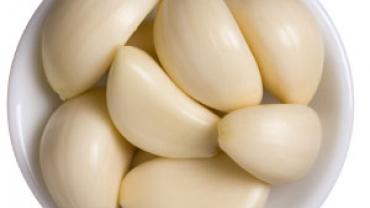
Garlic has held a place in folklore in many cultures and has been used for culinary and medicinal purposes for centuries. European folklore held that garlic had the ability to ward off evil and that wearing the cloves around your neck was a remedy for warding off vampires. Another popular myth held that dreaming about garlic was a sign of luck and insight into discovering hidden secrets. Roman soldiers even ate garlic for inspiration and courage but ascetics refused to eat it because of its aphrodisiac effects. Garlic also has a long history of deterring other blood-sucking creatures and was used as a mosquito repellent.
Given its widespread historical influence it seems likely that garlic has at least some factual force behind its fiction. Indeed extensive scientific studies on garlic have revealed a wide range of beneficial biological activities and the research continues to yield fascinating results.
Ironically the Greek name for garlic is Allium which means to avoid because of its offensive smell; however garlic really should be named something that means to use often because its strong odor is actually the source of its physiological potency.
The odor is the result of the breakdown of organosulfur compounds (OSCs) which have garnerd attention as antibacterial antilipidemic antifungal anti-inflammatory antiparasitic anti-tumorigenic anti-thrombotic antioxidant and antihypertensive. A simple search through PubMed where garlic is the subject of many studies proves that it has caught the attention of the medical community.
Garlic's potential as a medicinal giant is clear however how we harness its power is still very cloudy. Too often people buy garlic supplements without a full understanding of which components of garlic are effective and which ones aren't. For example cooked or processed garlic products show different kinds of garlic OSCs some of which are highly unstable and instantly decompose. This is the main reason studies show paradoxical results on the efficacy of garlic.
Researching traditional garlic therapies reveals some interesting science. Garlic oil macerate has been a popular health food in Europe for decades. It is prepared by mixing mashed or chopped garlic in vegetable oil and is the only garlic supplement that contains significant quantities of two specific OSCs ajoene and dithiin. Ajoene and dithiin are metabolites of a bioactive compound found in garlic called allicin. However this powerful source of ajoene and dithiin does not exist in fresh undamaged garlic cloves (so much for that necklace of garlic!). Allicin can only be produced by crushing garlic. This releases a critical enzyme (allinase) and breaks down the existing alliin into allicin; as a result ajoene and dithiin are produced.
Many dietary supplement companies claim to provide a product that delivers allicin -the precursor to ajoene and dithiin. However measurements in a laboratory differ from what actually happens in the human body. Once ingested the allinase enzyme is rapidly and completely destroyed by the stomach acid and without it allicin cannot be made. Many enteric-coated garlic supplements fail to release even 15% of their claimed allicin potential when placed in simulated intestinal fluid. Therefore it is better to use the inherently stable allicin metabolite ajoene.
Ajoene has been shown to have a synergistic antimicrobial effect with tobramycin which is exciting given that new treatment strategies for infections are becoming a high-priority research area particularly with the emergence of resistant bacterial strains. Ajoene was also found to boost the immune system by enhancing intestinal IgA production and is described as an allium antioxidant that enhances the action of antioxidant enzymes and the supply of ATP and other nutrients to the tissues.
Another review suggests that garlic and garlic-derived bioactives have the potential for ameliorating hypertension.
Although there may or may not be truth behind the folk tales of garlic they certainly reflect the incredible possibilities for helping the human body that lie hidden in this bulbous plant.